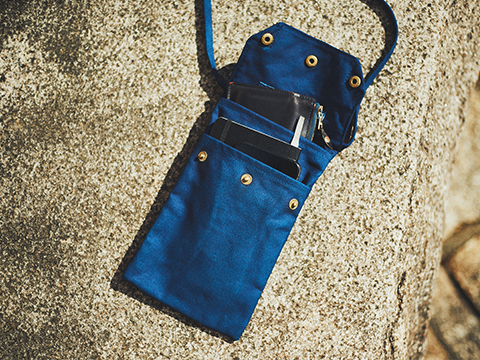Concept
"Glenroyal meets Craftspeople" is a new experiment born from the esteem for craftsmanship that goes into our own wares.
The focus of this project will be creating new products with artisans who work with traditional materials or special techniques that share a common note with the bridle leather that has become synonymous with our brand.
This initial instalment puts the spotlight on indigo dyeing, an art dear to Japan and the rest of the world since ancient times.
#01
Charms common to both bridle leather and indigo dye
Bridle leather and indigo dyeing share more than a few attractive features, one of which is their functionality. Being saturated with wax makes bridle leather both sturdy and resistant to water due to being rich in oil, and this is why it has found use in items such as horse tack. Indigo dye, on the other hand, not only strengthens threads, but is also said to possess antioxidant and disinfecting properties, to the point that it was used for armour and fire-fighting attire.
The second common appeal is that, while the indigo dye used with denim and the like is generally a chemical agent, the indigo dyeing featured here is a technique with natural origins referred to as "hon-aizome" (true indigo dyeing). In lieu of chemicals, the dyeing is done using liquid made from the fermented indigo leaves, with the result being a natural material in much the same manner as bridle leather. And just as bridle leather takes on gloss and texture the more they are used, products dyed with indigo also gain a deep blue hue over time.
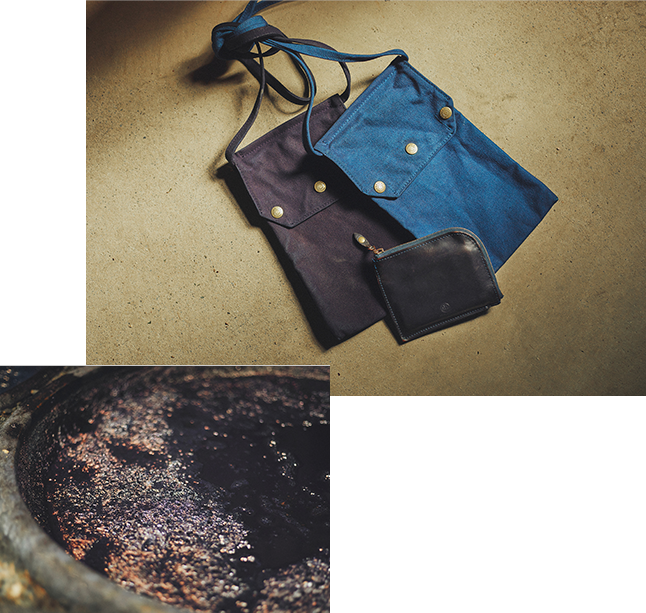
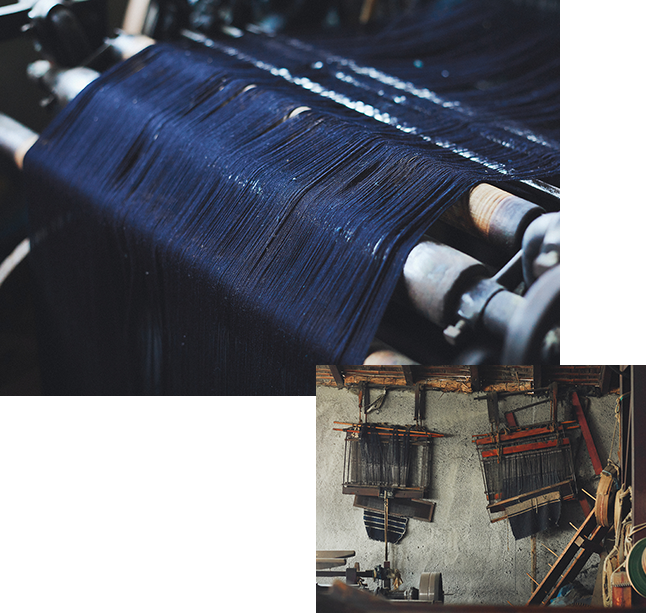
#02
The history of indigo and different varieties
The history of indigo is an ancient one, with the remains of dye vats having apparently been discovered in Indus Valley civilisation ruins dating back to around 3,000 B.C, which is where the technique originated before spreading to China and Europe. In Europe, a type of indigo known as "woad" was used in prehistoric times. Indigo cultivation became particularly prevalent in England, Germany and France around the sixth century, and eventually reached its peak during the sixteenth century. However, this was also around the time that a variety of indigo from India that could be cultivated more easily and produced richer tones appeared and replaced woad as the primary form of dye. Meanwhile, in Japan a method of indigo dyeing carried over from the mainland China in the Nara period (710-794 CE) became widespread. The technique, which employed mainly knotweed indigo, was used for a wide variety of items, and became an essential part of the people's lives in the Edo and Meiji periods. British chemist Robert William Atkinson, who visited Japan during the Meiji era, was so impressed by the beautiful indigo he saw throughout the cities that he called it "Japan blue".

#03
The allure of
the Shiga region
and true indigo dyeing
Indigo dyeing grew into an industry with several regional variants throughout Japan like Awa indigo in Tokushima Prefecture, or the Mashiko cotton of Tochigi. In this instalment of GLENROYAL meets CRAFTSPEOPLE, we will be looking at Omi cotton, which features a technique of true indigo dyeing from Shiga Prefecture that has become a rarity today. We worked with a studio that uses fermented knotweed indigo leaves in a traditional dyeing technique that also adds in other ingredients like lime or wheat bran and ferment.
The rich natural scenery of Shiga is another one of its appeals. The fact that this project focused on true indigo dyeing, a method that forgoes chemicals, was all the more reason to use pure water drawn from a well rather than a faucet. Shiga Prefecture is also famed for its "Oumi merchants". The Oumi district in Shiga has always been known for producing many tradesmen, as can be seen in how several companies renowned to this day like Toyota and Takashimaya have their roots in the region. It was thanks to the efforts of these merchants from Oumi that indigo products and other local goods spread throughout Japan in Edo period. The greatest charm of true indigo dye work from Shiga is the gorgeous deep blue tone that is unique to knotweed indigo leaves. Supposed flame-resistant, deodorization effect and antiseptic properties also helped make cloth dyed in this manner a popular choice as a practical material since olden times.

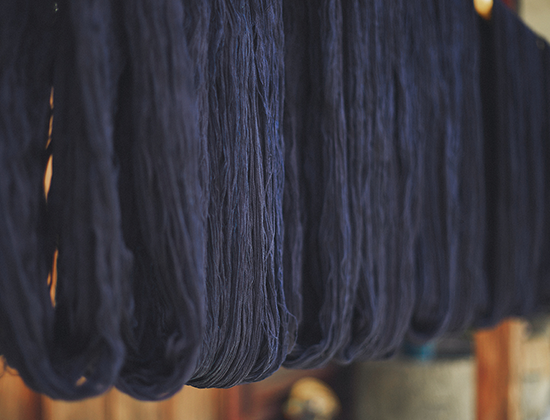
#04
Thread dyeing that helped make indigo popular
While Shiga indigo developed alongside Oumi cotton, it's no exaggeration to say that this was due to its technique thread dyeing. In other words, the dyeing was done while the cloth was still thread rather than later once it had been woven into its completed form. This in turn allowed for the creation of a wide variety of indigo goods that became favourites among much of the populace.
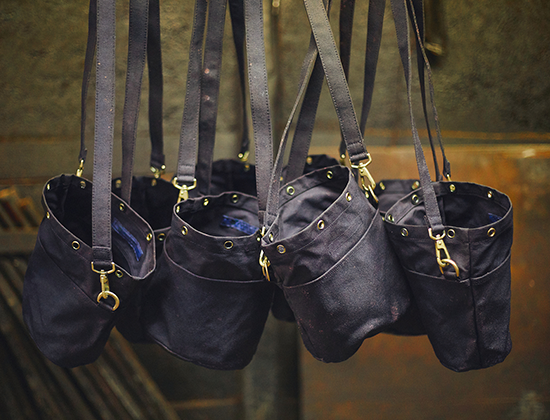
#05
Labour-intensive dyeing of finished items
The dyeing method used in this project is one that involves applying the indigo to an already-completed item. While on the one hand this makes it possible for the colour reaches even the smallest details of the product, it also requires a craftsman to inspect the dyeing of each item individually to ensure that there aren't any irregularities. Since the outcome of the dye changes depending on the shape of the product, the process is much more painstaking than that of thread dyeing, to the point where it could be said that this is the perfect place to let one's skills as a dye artisan shine.

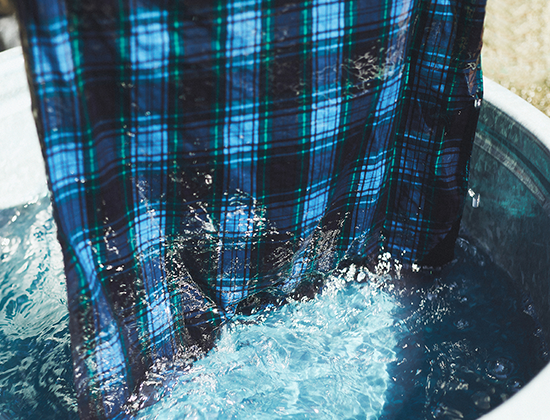
#06
Washing in water
for a refined look
After going through repeated cycle of dipping and wringing out, the item is then rinsed with water. This removes any excess indigo that did not take hold and creates a look that is the definition of refined. After the rinse, the item is then immersed in water once more to draw out the lye contained within the indigo dye. Doing so enhances the blue tone, allowing the true colour of the indigo to emerge. This is also the origin of the phrase "aka nukeru", which in Japanese refers to "to be stylish".
#07
Indigo, a beloved dye among travellers
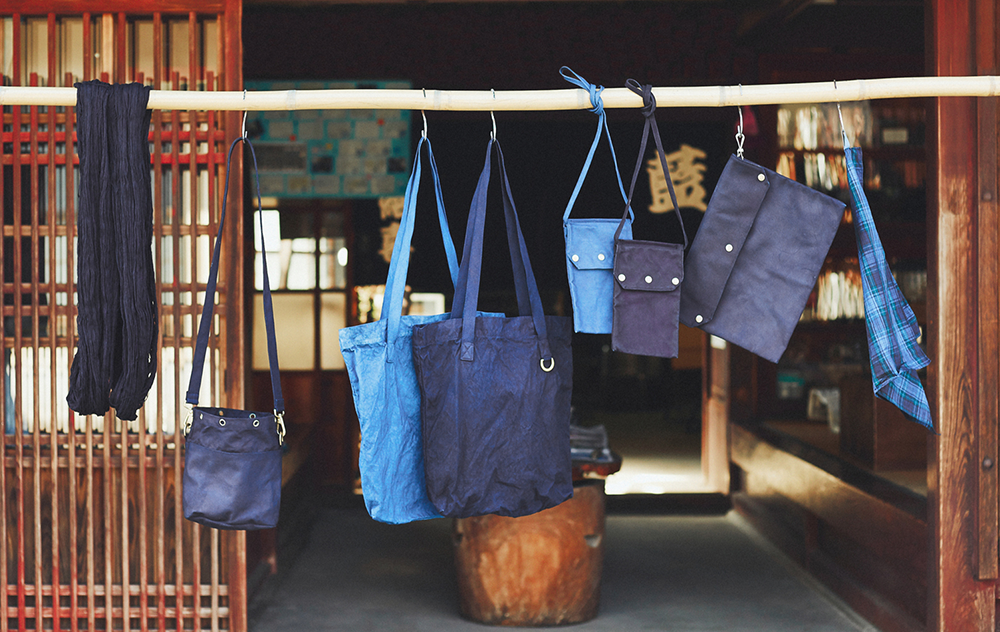
Thanks to careful preparation using natural materials, as well as the antibacterial and odour-eliminating properties, products made with true indigo dyeing have long been favourites among those who live their lives on the road. What's more, the true indigo process actually increases the durability of the fabric and turns it into an optimal material for travel. The seeds and leaves of the indigo plant that serve as the source of the dye were also apparently once used as medicine and considered a travel essential. All of the products from this project possess the unique antibacterial and odour-resistant characteristics of true indigo items, making it the perfect collection for excursions away from home, be they for business or pleasure.
Alternating use of the traditionally deep "Japan blue" indigo and the "Scottish blue" also found in the national flag of Scotland, the birthplace of Glenroyal, produced a set of tones that truly symbolizes the spirit of this project.
A collection filled with dazzling blues that captivate the eye and transform with use, as well as the unique durability, odour-resistance and antibacterial properties of true indigo. Each item has been designed with various travel scenarios in mind, such as being easy to carry on the go, or having a smart amount of storage capacity. In light of the craftsmanship and history behind the so rarely seen today traditional techniques that goes in to making true indigo and bridle leather, you'll find no better companions to join you in the journey of life.

The collection
can be purchased directly
from our online import agent shop.
